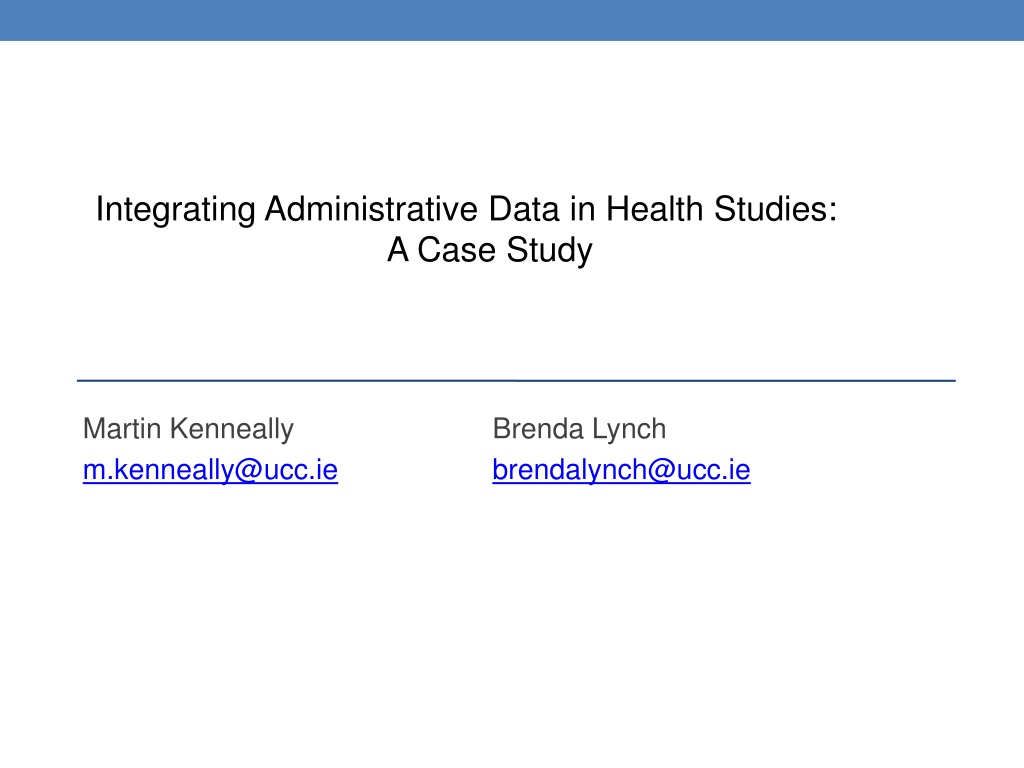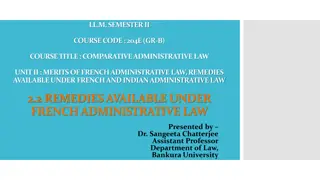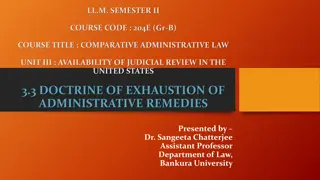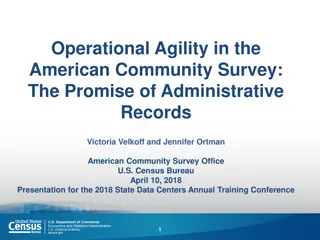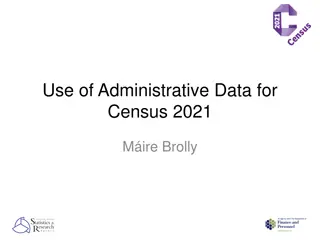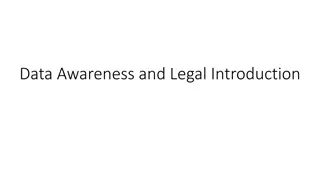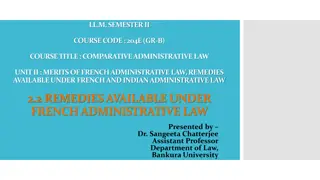Integrating Administrative Data in Health Studies: A Case Study
This case study explores the integration of administrative data in health studies focusing on profiling the health status of Irish regions in 2010. The objectives include linking regional health profiles to prescribing patterns, incorporating demographics and drug scheme coverage rates, and simulating the effects of health status on prescribing outcomes. The study aims to identify correlates of health status and create a composite Health Index to benchmark regional health status. Challenges include discrepancies in definitions and concepts among databases. Official datasets utilized include QNHS Health Module, IPH morbidity data, PCRS drug scheme coverage, and Health Atlas, among others. Data gaps exist regarding specific health conditions, age limitations, and crosstabulation of conditions by region and medical cover.
Download Presentation

Please find below an Image/Link to download the presentation.
The content on the website is provided AS IS for your information and personal use only. It may not be sold, licensed, or shared on other websites without obtaining consent from the author. Download presentation by click this link. If you encounter any issues during the download, it is possible that the publisher has removed the file from their server.
E N D
Presentation Transcript
Integrating Administrative Data in Health Studies: A Case Study Martin Kenneally m.kenneally@ucc.ie Brenda Lynch brendalynch@ucc.ie
Objectives Profile the Health Status of Irish Regions (2010) Link Regional Health Profiles to Regional Prescribing. Incorporate Regional Demographics, Community Drug Scheme Coverage rates and Prescribing Norms Simulate effects of Health Status, GMS coverage & Demographics on Prescribing Rates & Cost outcomes. Identify correlates of health status
Profile Regional Health Status Construct a Composite Health Index to; (a) Calibrate the health status of 8 Irish regions below (b) Use Ireland as Standard with base value of 100. Regions 1. East 2. Midlands 3. Mid West 4. North East 5. North West 6. South East 7. South West 8. West Counties Wicklow Longford N Tipperary Meath Sligo S Tipperary Dublin Laois Clare Cavan Donegal Carlow Cork Galway Kildare Offaly Limerick Louth Leitrim Kilkenny Kerry Mayo W. Meath Monaghan Waterford & Wexford Roscommon
Profiling Steps 1. Select Health Indicators: (mainly morbidity rates) for each type of major health condition 2. Standardized Rates = national/regional morbidity rate *100 3. Aggregate Rates: using Prescription Weights. 3(a) Aggregate separatelyfor GMS, DP and LTI drug schemes in each region. 3(b) Then Aggregate across schemes in a region (using coverage weights) to obtain that region s Regional Health Index (i) Use Index to Benchmark Regional Health Status (ii) Use Index to Benchmark Regional Health Gaps (iii) Simulate selected policy outcomes (iv) Identify Correlates of Health Status & Health Gaps
Official/Administrative Datasets Available Official: CSO e.g. QNHS Health Module (Used) Admin: non-CSO, respondent centred, dedicated focus e.g. IPH: General. Morbidity Prevalence Rates by County (Used) PCRS: Drug Scheme Coverage & Prescribing data (Used) Health Atlas: Focus on Public Patients Tilda: Focus on Over 50s (Ageing) SLAN: Focus on Lifestyle, Attitudes & Nutrition. Periodic. CME: General, 2008/9 only [BNF not ICD codes used]. Technical Challenges Missing Definitions, sources and methods Disjoint Definitions/Concepts e.g. CSO vs PCRS regions
Health Data Gaps QNHS Health Module covers 19 Health Conditions: (i) Adults only (excludes under 18s) (ii) Rates refer to at any time in a respondent s past (iii) Excludes GERD & pregnancy/immunization services and (iv) Does not cross-tabulate conditions by region/medical cover. PCRS: Publishes prescribing by scheme, region, age & gender but does not publish allied morbidity rates on the same basis. Upshot, we don t know; (i) (ii) (iii) How much prescribing rates reflect ill-health v s health cover How much morbidity rates of public & private patients differ How much GP visit rates reflect ill-health v s type of health cover
Community Drug Schemes Incorporated Incorporated 1. GMS (General Medical Services) Means tested. Income adjusted for mortgage/housing, childcare, travel costs, savings etc. Discretionary Medical Cardalso granted to avoid unduehardship . 2. DP (Drug Payment Scheme) Not means tested. Person/family pays first 144/month; HSE pays any excess 3. LTI (Long Term Illness) Not means tested. Schedule includes - Cerebral Palsy, Spina Bifida, Epilepsy Acute Leukaemia, Multiple Sclerosis, Diabetes & *************************************************************************************** Not incorporated HTD (High Tech Drug Scheme) mainlyhospital originated anti-rejection drugs for transplants and chemotherapy
Regional Population % Covered by Each Scheme in 2010 GMS DP LTI HTD All Ireland 35 61 3 1 100 100 1.East 28 67 4 1 100 2. Midlands 38 58 3 1 100 3. Mid-West 38 59 2 1 100 4. North-East 38 58 3 1 100 5. North-West 49 47 3 1 100 6. South-East 41 55 3 1 100 7. South 36 61 2 1 100 8. West 41 56 2 1
Methodology 1) Select 28 health indicators (18 prevalence rates/10 others) 2) Assign to 6 ATC Health Categories/Dimensions: Alimentary, Cardio, CNS, Respiratory, Various & Other 3) Break down 6 ATC categories into 24 Therapeutic Drug Groups 4) Construct(prescription weighted) Composite Health Indices for the 6 ATC categories under each scheme in each region. 5) Aggregate scheme-specific Indices into Regional Indices (using scheme coverage weights). Base Value is Ireland = 100
KL Composite Health Index Index 115 110 105 100 95 90 85 80 Midlands - 91.89 North West - 94.04 West - 96.52 South East - 97.05 Republic of Ireland - 100 South - 100.48 North East - 102.31 Mid West - 103.92 East - 106.14 Region
Largest Health Gaps by ATC Category Index 135 130 Mid West - 129.56 125 120 115 North East - 108.25 110 East - 105.50 ROI - 100 Best Health Worst Health East - 104.39 East - 107.91 105 West - 102.26 100 ROI - 100 Mid - 92.91 95 Mid-West - 95.76 90 Mid - 95.15 North West - 91.28 Mid - 86.87 85 Mid - 84.97 80 75 70 VARIOUS ALIMENTARY TRACT NERVOUS SYSTEM OTHER CARDIOVASCULAR RESPIRATORY SYSTEM ATC Category
Health Gaps & Weights in East & Midlands Regions % 30 20 22.93 10 14.22 13.10 10.79 5.85 4.75 0 Absolute difference between East's CHI and Midland's CHI 7.99 2.46 12.85 16.58 -10 26.02 32.54 -20 National ATC % Weighting -30 -40 ATC Category ALIMENTARY TRACT VARIOUS NERVOUS SYSTEM OTHER RESPIRATORY SYSTEM CARDIOVASCULAR
Simulated Prescribing & Cost Outcomes We constructed & validated a simulation model. Simulation Model incorporatesregional health status, scheme coverage & prescribing norms; Simulates number & type of drug prescribed in each region in 2010 with high (97%) accuracy Prescribing semi-elasticity w.r.t. GMS coverage is twice semi- elasticity w.r.t. health-status Pattern and causes of regional unit drug cost variations still under investigation.
Income, Demographics, Coverage & Health Status CSO Disposable Income 2010 Percentage Aged over 65 % Covered by GMS Composite Health Index Region 20,300 10.00% 28% 106.14 East 19,300 11.10% 35% 100.00 Republic of Ireland 19,200 12.00% 36% 100.48 South 19,100 11.80% 38% 103.92 Mid West 18,500 12.30% 41% 96.52 West 18,100 12.00% 41% 97.05 South East 17,300 10.00% 38% 102.31 North East 17,300 13.00% 49% 94.04 North West 17,100 11.00% 38% 91.89 Midlands
Unanswered Questions & Policy Issues 1) Macro-causality pattern of regional health status remains Smudged 2) Ground-clearing : lacking the with precision of, say, Kabir et al. 2013 on CHD 3) North-West v s North East (for example): Why is GMS cover in NW so much higher? (Equity) Is poorer NW health status due to poor demographics? How much do other factors contribute to health status?
Recommendations to Increase Usability Working Party of Official & Admin Groups to Agree; Common and individual domains Common base observation unit (e.g. DEDs for SAPS & Census) Common publication unit (NUTS3 or NUTS4) Harmonised methodologies. Definitions, Sources and Methods manual (IPH/PCRS) Linked prescribing and morbidity data (for policy analysis) Published accessible anonymised (Statbank style) Archive Tables Increased professional statistical input The End
